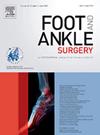Comparative study of subtalar arthroereisis, medializing calcaneal osteotomy and the combination of both techniques for the treatment of symptomatic adult flatfeet
IF 1.9
3区 医学
Q2 ORTHOPEDICS
引用次数: 0
Abstract
Background
Symptomatic adult flatfeet are a common problem that is treated with various therapeutic approaches. In this study, three different surgical approaches, subtalar arthroereisis (SA), medializing calcaneal osteotomy (MDCO) and a combination of both techniques (SA+MDCO) were analyzed.
Methods
32 patients (36 feet) with pes planovalgus (mean age 49 +/- 16 years) were surgically treated with either SA (n = 8 feet), MDCO (n = 9 feet) or SA+MDCO (n = 19 feet). The American Orthopaedic Foot and Ankle Society (AOFAS) and the European Foot and Ankle Society (EFAS) questionnaires, as well as radiological parameters were compared before and after surgery within and between groups. At follow up (6 +/- 2 years) patients were additionally invited for dynamic pedobarography and static hindfoot axis examination.
Results
Within all three groups AOFAS and EFAS questionnaire values and radiological parameters improved significantly after surgery. Questionnaires did not differ between all groups. Before surgery the SA+MDCO group displayed the most severe radiological flatfeet parameter in comparison to the other cohorts. After surgery, the SA and SA+MDCO groups were greatly improved, while the MDCO group displayed less correction, indicating poorer surgical results with MDCO only. Pedobarography of surgically treated feet revealed similar results in comparison to the contralateral side within all three groups and all feet displayed a normal gait line after surgery.
Conclusions
Analyzing questionnaires and radiographs, all three surgical techniques (SA, MDCO and SA+MDCO) significantly improved the severity of flatfoot deformity. Pedobarography revealed similar dynamic properties of treated feet in comparison to the contralateral side. While treatment with SA showed better results than treatment with MDCO alone, the combination of SA+MDCO was most effective. In this study, severe adult flatfeet benefited most from a surgical combination of SA+MDCO with respect to normalization of radiological parameter.
Level of Evidence/Clinical relevance
Therapeutic Level III
治疗有症状的成人扁平足的足底关节切开术、小腿内侧截骨术和两种技术联合应用的比较研究。
背景:有症状的成人扁平足是一种常见问题,治疗方法多种多样。本研究分析了三种不同的手术方法,即足底关节切开术(SA)、小腿内侧截骨术(MDCO)和两种技术的组合(SA+MDCO)。方法:32 名扁平足患者(36 只脚)(平均年龄 49 +/- 16 岁)接受了手术治疗,包括 SA(8 只脚)、MDCO(9 只脚)或 SA+MDCO(19 只脚)。术前和术后,在组内和组间比较了美国骨科足踝协会(AOFAS)和欧洲足踝协会(EFAS)的问卷调查以及放射学参数。随访期间(6 +/- 2年),患者还需接受动态足底照相术和静态后足轴线检查:结果:手术后,所有三组患者的 AOFAS 和 EFAS 问卷调查值以及放射学参数均有明显改善。各组之间的问卷调查结果没有差异。与其他组别相比,SA+MDCO 组在手术前显示出最严重的放射性扁平足参数。术后,SA组和SA+MDCO组的情况大为改善,而MDCO组的矫正效果较差,表明仅使用MDCO的手术效果较差。手术治疗足部的足底X光片显示,三组患者的手术效果与对侧相似,术后所有足部均显示出正常的步态线:通过问卷调查和X光片分析,三种手术方法(SA、MDCO和SA+MDCO)都能显著改善扁平足畸形的严重程度。足底照相术显示,接受治疗的足部与对侧足部具有相似的动态特性。虽然使用 SA 的治疗效果优于单独使用 MDCO 的治疗效果,但 SA+MDCO 的组合治疗效果最好。在这项研究中,严重的成人扁平足从SA+MDCO联合手术中获益最大,放射学参数趋于正常:证据级别/临床相关性:治疗级别 III。
本文章由计算机程序翻译,如有差异,请以英文原文为准。
求助全文
约1分钟内获得全文
求助全文
来源期刊

Foot and Ankle Surgery
ORTHOPEDICS-
CiteScore
4.60
自引率
16.00%
发文量
202
期刊介绍:
Foot and Ankle Surgery is essential reading for everyone interested in the foot and ankle and its disorders. The approach is broad and includes all aspects of the subject from basic science to clinical management. Problems of both children and adults are included, as is trauma and chronic disease. Foot and Ankle Surgery is the official journal of European Foot and Ankle Society.
The aims of this journal are to promote the art and science of ankle and foot surgery, to publish peer-reviewed research articles, to provide regular reviews by acknowledged experts on common problems, and to provide a forum for discussion with letters to the Editors. Reviews of books are also published. Papers are invited for possible publication in Foot and Ankle Surgery on the understanding that the material has not been published elsewhere or accepted for publication in another journal and does not infringe prior copyright.
 求助内容:
求助内容: 应助结果提醒方式:
应助结果提醒方式:


